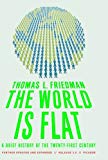
The World Is Flat is a book by Thomas Friedman discussing the trends of globalization in the 21st century. Friedman describes himself as a "free-trader," arguing in favor of the rapid shifts towards a more interconnected economic world after the fall of the USSR as a result of the Internet, computers, outsourcing and workflow software. Friedman also presents his controversial Dell Theory of Conflict Prevention: that corporations' increased dependency on foreign labor and resources will prevent armed conflict.
We begin by examining two significant dates in world flattening: 11/9 as an example of creative imagination and 9/11 as destructive imagination. 11/9, with the destruction of the Berlin Wall, was the door opening to a freer, flatter, and more democratic world, where 9/11 saw our world try to snap shut against outside threat. This is Friedman’s call for positive creativity and giving people the tools to do positive things with what is available through the opening of so many doors.
We see the innovation and creativity that Bin Laden put into his 9/11 plan, as horrible as it was. Friedman concludes that the forces that flatten the world can be used to bring everyone up to the same level, or to bring them all down to the same level. Those of us who live in free and progressive societies must lead others to use their imaginations without allowing their imaginations to get the best of them– or us. Technology cannot protect us; we must harness that technology and decide how it will be used. This requires us to define the line between precaution and paranoia to keep things in perspective in a flat world. We are called to remember who we are to avoid losing our identity in a flat world. In exploring eBay as a virtual community, India as the second largest Muslim country where the context and imagination are different than in other parts of the Arab world, and the curse of oil and how it keeps countries from moving forward in other ventures, we learn about different types of creativity.
Friedman reflects on his story of Aramex from Chapter Eleven as an inspirational closing thought; one of a small Arab company that made it big in the world platform.
Already have an account? Log In Now